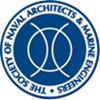基于混合欧拉-拉格朗日方法的甲板绿水数值模拟
IF 1
4区 工程技术
Q3 ENGINEERING, CIVIL
引用次数: 5
摘要
在波涛汹涌的海况下,甲板上的绿水可能会对上层结构产生极端的冲击波冲击,并导致严重的结构损伤。在船舶结构设计中考虑绿色水荷载具有重要意义。然而,由于波浪与船舶的强非线性相互作用以及波浪冲击现象的多相、多尺度性质,预测绿色水荷载存在许多挑战。本文提出了一种三维混合欧拉-拉格朗日方法来模拟船舶甲板上的绿色水荷载。它是从一种高效、精确的二维流体-结构相互作用方法扩展而来的。在这种方法中,流场是在欧拉框架中的固定规则笛卡尔网格系统上求解的,而固体运动是用一组浸入流体中的标记来跟踪的,并在拉格朗日框架中求解。模拟了两个基准案例,即固定简化浮式生产储油和卸载(FPSO)模型上的绿色水和船上的绿色水情况。实验数据和数值结果的比较表明,我们的方法是预测绿色水负荷的可行选择。本文章由计算机程序翻译,如有差异,请以英文原文为准。
Numerical Simulation of Green Water on Deck with a Hybrid Eulerian-Lagrangian Method
Green water on the ship deck in rough sea conditions may induce extreme impulsive wave impacts on superstructures and result in severe structural damage. It is of great importance to consider green water loads in ship structure design. However, there are many challenges in predicting green water loads due to the strongly nonlinear wave-ship interactions and the multiphase, multi-scale nature of the wave impact phenomena. In this article, a three-dimensional hybrid Eulerian-Lagrangian approach is proposed for simulating green water loads on the ship deck. It is extended from an efficient and accurate two-dimensional method developed for fluid-structure interaction problems. In this method, the flow field is solved on a fixed regular Cartesian grid system in an Eulerian framework, whereas the solid body motion is tracked with a set of markers immersed in the fluid and solved in a Lagrangian framework. Two benchmark cases, green water on a fixed simplified Floating Production Storage and Offloading (FPSO) model and green water on ship, are simulated. Comparison between experimental data and numerical results shows that our method is a viable choice for predicting green water loads.
求助全文
通过发布文献求助,成功后即可免费获取论文全文。
去求助
来源期刊

Journal of Ship Research
工程技术-工程:海洋
CiteScore
2.80
自引率
0.00%
发文量
12
审稿时长
6 months
期刊介绍:
Original and Timely technical papers addressing problems of shipyard techniques and production of merchant and naval ships appear in this quarterly publication. Since its inception, the Journal of Ship Production and Design (formerly the Journal of Ship Production) has been a forum for peer-reviewed, professionally edited papers from academic and industry sources. As such, it has influenced the worldwide development of ship production engineering as a fully qualified professional discipline. The expanded scope seeks papers in additional areas, specifically ship design, including design for production, plus other marine technology topics, such as ship operations, shipping economic, and safety. Each issue contains a well-rounded selection of technical papers relevant to marine professionals.
 求助内容:
求助内容: 应助结果提醒方式:
应助结果提醒方式:


